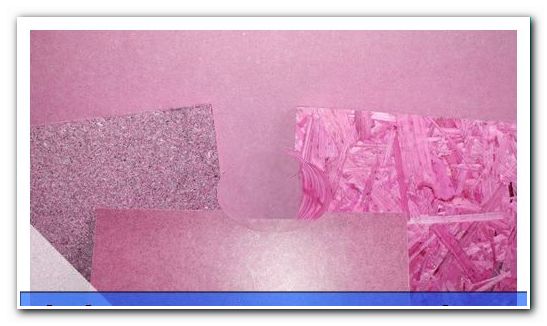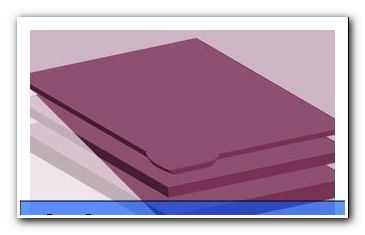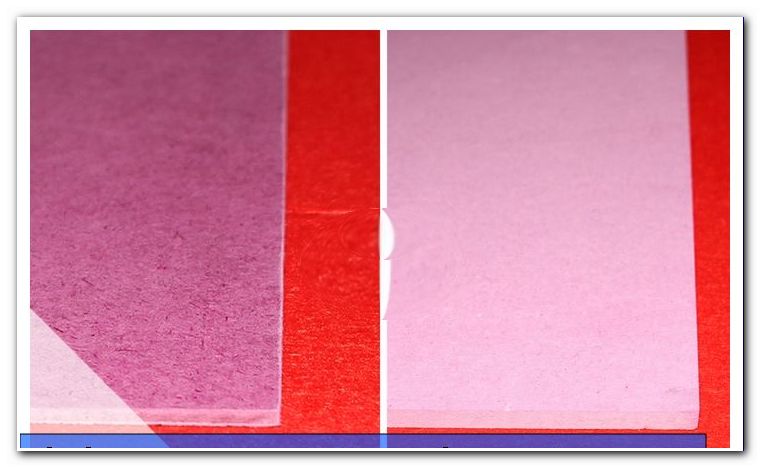MDF boards - information on strengths, sizes and prices

- What are MDF boards "> Various special boards
- MDF B1
- Conductive plate
- Topan form of the company Glunz AG
- Moisture-resistant MDF board
- Prices for the plates
- Cost of the plates
- Calculate density
- Determine the weight of the plate
MDF boards are used in construction in many different areas. Whether for interior design or for the production of furniture - by the knowledge of the characteristics you select fast the suitable models. In our guide we have compiled all important information on the strengths, the sizes and the prices.
When planning a construction project, choosing the right materials is crucial. Here, both the dimensions and the quality must be right. However, the prices for wood panels differ greatly. They depend on various factors such as strength and size. Therefore, you must determine exactly what thickness and area you need. The higher the strength, the more stable the plate, although the price increases. After all, weight plays a decisive role in many areas, for example if the place of attachment has a certain carrying capacity. Therefore, find out how to calculate the information you are looking for from the given information.
What are MDF boards?
An MDF board is a medium density fiberboard. The building material owes this name to the fact that the density lies between the values of wet fiber boards and sawn timber. A distinction is also made between three different groups of medium-density fiberboard, which have a different density:
- Ultra-light plate: up to 550 kg / m³
- Lightweight MDF board: 550 kg / m³ to 650 kg / m³
- classic MDF board: 650 kg / m³ to 800 kg / m³
The medium-density fibreboards are made of the finest-shredded wood, usually softwood. By means of a compression, a homogeneous building material is produced. This is characterized by its smooth edges and high stability. The commercial densities available are between 550 kg / m³ and 1, 000 kg / m³. There are also various thicknesses, with the spectrum generally ranging from 2 mm to 60 mm. The fiberboards are often used as substitutes for chipboard, because the edges can be profiled and painted particularly well.

Various special plates
MDF B1
Models of this category are particularly flame retardant. They are therefore often used for interior design, insofar as the fire protection is to be optimized. For some manufacturers, the plates have a reddish core. This is deliberately created to mark the plates. However, in practice, the coloring can be disturbing if the plate is cut and thus the interior becomes visible.
Conductive plate
By means of a powder coating is achieved that the plate has a certain conductivity. The coating process achieves electrostatic properties. However, these variants are rarely encountered in practice because the results have fallen short of expectations.
Topan form of the company Glunz AG
The topan shape features a flexible medium density fiberboard.
Moisture-resistant MDF board
Thanks to a special coating, the panels are resistant to moisture. They can thus also be used in damp rooms, for example in the bathroom. When selecting, you must pay attention to the degree of water resistance, as there are great differences. However, each plate swells when it reaches a certain amount of water, so that the moisture resistance refers only to the swelling behavior of the plates.
Prices for the plates
 The prices for fiberboard depend on various factors. Decisive factors include:
The prices for fiberboard depend on various factors. Decisive factors include:
- the decor
- the strengths
- the sizes
In order to be able to compare the costs of fiberboard in spite of the different sizes, we compared the square meter prices. Below you will find a list of usual market prices for end customers. These are blank plates that can be brought to the size you need:
Color: nature (supplier Bauhaus, as of December 2015)
Plate 1: With a thickness of 3 millimeters, this fiberboard costs 4.30 euros per m².
Plate 2: With a thickness of 5 millimeters, it costs 5.90 euros per m².
Plate 3: With a thickness of 10 millimeters, this costs 8.60 euros per m².
Plate 4: With a thickness of 16 millimeters, this costs 11.55 euros per m².
Plate 5: The 19-millimeter-thick fiberboard costs 13.10 euros per m².
The prices can be regarded as representative, since the selling prices for end customers in the specialized trade are similar. However, it must be taken into account that, depending on the coloration of the plates, once again clear price increases are possible.
Cost of the plates
 Example: The price for a 10 mm thick and 2 x 1 meter MDF sheet from Bauhaus
Example: The price for a 10 mm thick and 2 x 1 meter MDF sheet from Bauhaus
Step 1: Determine the area of the plate.
To calculate the required square meters, multiply the length and width of the fiberboard. In this case the size is 2 mx 1 m = 2 m².
Step 2: Calculation of the final price
Now multiply the size by the square meter price:
2 m² x 8, 60 Euro = 17, 20 Euro
Thus, the required fiberboard costs 17.20 euros . Deviations may arise if the provider has specified a certain width. To avoid waste, it can be determined which width has to be paid. In this case, different variants of a thickness are offered, so you pay for the plates by length.
Example: If widths of 1 meter, 1.50 meters and 2 meters are offered, then you have to pay for a 1.30 meter wide plate the price for the width of 1.50 meters.
Tip: In this case, if you wish, you can take along the cut-off board of width 1.50 m - 1.30 m = 0.20 m, as this could possibly be required during the work and has already been paid.
With the help of a saw, the plates can be easily cut at home. However, the cut in the retail trade has the advantage that the edges can be cut extremely clean due to the special performance of large machines.
Calculate density

The density of the plate depends on the following factors:
- mass
- Strength
- Size (length and width)
Suppose a disk has the following data:
- Weight: 10 kilograms
- Thickness: 10 mm
- Size: 1 m² (for example 1 mx 1 m)
Then the density of the fiberboard is calculated as follows:
- First of all, you have to determine the volume of the plate. To do this, multiply the length by the width and the thickness.
Volume = 1 mx 1 mx 0.01 m = 0.01 m³
- For the density, the formula applies: density = weight / volume
If one uses the values, then results:
Density = 10 kilograms / 0.01 m³ = 1, 000 kg / m³
Thus, the plate has a density of 1, 000 kg / m³ .
Determine the weight of the plate
The weight of the plate can be determined from the size, the thickness and the density. Suppose a disk has the following data:
- Size 1 mx 1 m
- Thickness 10 mm
- Density 1, 000 kg / m³
Then you can determine the weight using the formula: Weight = Density x Volume
In our case this results in the following calculation: Weight = 1.000 kg / m³ x volume
The volume is length x width x thickness, ie 0.01 m³. Thus, the plate weighs 10 kilograms .
Tips for quick readers
- Prices depend on strength and size
- Costs can be calculated by square meter
- In many cases certain latitudes have to be paid
- Decor can determine price
- Cutting is possible
- Density = weight / volume
- Weight = density x volume
- Densities are between 550 and 1, 000 kg / m³
- Thicknesses are possible from 2 to 60 mm
- Sizes are tailored by the specialized trade




